This is an old revision of this page, as edited by 173.24.117.126 (talk) at 17:49, 27 October 2010 (Correcting titles.). The present address (URL) is a permanent link to this revision, which may differ significantly from the current revision.
Revision as of 17:49, 27 October 2010 by 173.24.117.126 (talk) (Correcting titles.)(diff) ← Previous revision | Latest revision (diff) | Newer revision → (diff) "DOY" redirects here. The term may also refer to "day of year," called an Ordinal date. For the nursery rhyme, see The Grand Old Duke of York. For the ships, see HMS Duke of York.
The title The Duke of York is a title of nobility in the British peerage. Since the 15th century, it has, when granted, usually been given to the second son of the British monarch. Since the second creation (1474), not one of the holders of the title has ever passed it on: they either died without male heirs or became King themselves.
The current Duke of York is The Prince Andrew, second son of Queen Elizabeth II. Andrew currently has no male heirs and (since his 1996 divorce) is unmarried.
The wife of the Duke of York is known as the Duchess of York.
History
In medieval times, York was the main town of Northern England, and Yorkshire was England's largest shire.
In the interval between the fall of Jorvik under Eirik Bloodaxe, last King of Jorvik, and the first creation of the Dukedom of York, there were a few Earls of York.
The title Duke of York was first created in the Peerage of England for Edmund of Langley, the fourth surviving son of Edward III, and an important character in Shakespeare's Richard II. His son Edward, who inherited the title, was killed at the Battle of Agincourt in 1415. The title passed to his nephew Richard, the son of Richard of Conisburgh, 3rd Earl of Cambridge (who had been executed for plotting against King Henry V). The younger Richard managed to obtain a restoration of the title, but when his eldest son, who inherited the title, became King in 1461 as Edward IV, the title merged into the Crown.
The title was next created for Richard of Shrewsbury, second son of King Edward IV. Richard was one of the Princes in the Tower, and, as he died without heirs, the title became extinct at his death.
The next creation was for Henry Tudor, second son of King Henry VII. When his elder brother Arthur, Prince of Wales, died in 1502, Henry became heir to the throne. When Henry ultimately became King Henry VIII, his titles merged into the crown.
The title was created for the fourth time for Charles Stuart, second son of James I. When his elder brother, Henry Frederick, Prince of Wales, died in 1612, Charles became heir. He was created Prince of Wales in 1616 and eventually became Charles I in 1625 when the title again merged into the Crown.
The fifth creation was in favour of James Stuart, the second son of Charles I. The city and state of New York in what is now the United States of America were named for this particular Duke of York. When his elder brother, King Charles II, died without heirs, James succeeded to the throne as King James II, and the title once again merged into the Crown.
In the early 18th century, the Jacobite claimant to the throne, James Francis Edward Stuart, son of James II, granted the title "Duke of York" (in the Jacobite Peerage) to his own second son, Henry. James Francis Edward Stuart was known to those who rejected his claims as "The Old Pretender"; his elder son Charles was called "The Young Pretender", and "Bonnie Prince Charlie", and the younger son, Henry, who became a Roman Catholic cardinal, was known as the Cardinal Duke of York. To the Jacobites, they are Kings James III, Charles III, and Henry IX, respectively. (From the Jacobite perspective, this creation of the title merged into the Crown with Charles' death without legitimate issue, and Henry's succession to his rights.)
During the 18th century the Dukedom of York and Albany was created a number of times in the Peerage of Great Britain. The title was first held by Duke Ernest Augustus of Brunswick-Lüneburg, Bishop of Osnabrück, the youngest brother of King George I. He died without heirs. The second creation of the Dukedom of York and Albany was for Prince Edward, younger brother of King George III, who also died without heirs, having never married. The third and last creation of the Dukedom of York and Albany was for Prince Frederick Augustus, the second son of King George III. He served as Commander-in-Chief of the British Army for many years, and was the original "Grand old Duke of York" in the popular rhyme. He too died without heirs.
The sixth creation of the Dukedom of York was for Prince George of Wales, second son of Albert Edward, Prince of Wales, the future King Edward VII. He was created Duke of York following the death of his elder brother, Prince Albert Victor, Duke of Clarence. The title merged with the crown when George succeeded his father as King George V.
The seventh creation was for Prince Albert, second son of King George V, and younger brother of the future King Edward VIII. Albert came unexpectedly to the throne when his brother abdicated, and took the name George VI, the Dukedom then merging into the crown.
The most recent creation was for Prince Andrew, second son of Queen Elizabeth II. As of the present day, he only has two daughters. Thus, if he has no future sons, which seems likely, the title will become extinct at his death. If the tradition of awarding the title to the second son of the monarch were to continue, the title would then be awarded to Prince Harry, the younger son of Charles, Prince of Wales and the late Diana, Princess of Wales, the current heir apparent to the throne. Titles are traditionally given on marriage and if Harry's marriage predated Andrew's death, another title would presumably be awarded instead (following the precedent of the Earldom of Wessex being awarded to the current Duke of York's brother, Prince Edward, with the promise of the Dukedom of Edinburgh being granted to him at a later date, Prince Harry may be created an Earl with the expectation of being created Duke of York on his uncle's death).
Aside from the first creation, every time the Dukedom of York has been created it has had only one occupant, that person either inheriting the throne or dying without male heirs. This has fuelled the rumour that the title is cursed.
Dukes
Dukes of York
First creation, 1385–1415, 1425–1461
| Name | Portrait | Birth | Marriage(s) | Death |
|---|---|---|---|---|
| Edmund of Langley House of York (founder) 1385–1402 also: Earl of Cambridge (1362) |
 |
5 June 1341 Kings Langley son of Edward III of England and Philippa of Hainault |
Isabella of Castile 1372 3 children Joan de Holland no children |
1 August 1402 |
| Edward of Norwich House of York 1402–1415 also: Duke of Aumale (1397–1399), Earl of Cambridge (1362–1414), Earl of Rutland (1390–1402), Earl of Cork (c. 1396) |
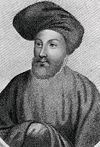 |
1373 Norwich son of Edmund of Langley and Isabella of Castile |
Philippa de Mohun no children |
25 October 1415 Agincourt aged 42 |
| Edward of Norwich's brother, Richard of Conisburgh, had been attainted and executed for treason in August 1415. This attainture stood in the way of his son Richard Plantagenet succeeding Edward until the king deemed it prudent to restore them. | ||||
| Richard Plantagenet House of York 1425–1460 also: Earl of Ulster (1264), Earl of March (1328), Earl of Cambridge (1414, restored 1426), feudal Lord of Clare (bt. 1066–1075), Baron Mortimer of Wigmore (1331) |
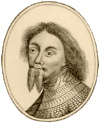 |
21 September 1411 son of Richard of Conisburgh, 3rd Earl of Cambridge and Anne de Mortimer |
Cecily Neville 1437 13 children |
30 December 1460 Wakefield aged 49 |
| Edward Plantagenet House of York 1460–1461 also: Earl of Ulster (1264), Earl of March (1328), Earl of Cambridge (1414), feudal Lord of Clare (bt. 1066–1075), Baron Mortimer of Wigmore (1331) |
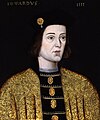 |
28 April 1442 Rouen son of Richard Plantagenet and Cecily Neville |
Elizabeth Woodville 1 May 1464 10 children |
9 April 1483 Westminster aged 40 |
| Edward Plantagenet seized the throne as Edward IV in 1461, and all of his titles merged with the crown. | ||||
Second creation, 1474–1483
| Name | Portrait | Birth | Marriage(s) | Death |
|---|---|---|---|---|
| Richard of Shrewsbury House of York 1474–1483 also: Duke of Norfolk (1477), Earl of Nottingham (1476), possibly Earl of Warenne (1477) |
 |
17 August 1473 Shrewsbury son of Edward IV of England and Elizabeth Woodville |
Anne de Mowbray, 8th Countess of Norfolk 15 January 1478 no children |
unknown |
| How Richard died is a controversial, frequently debated topic and there is no solid evidence for his date, age or place of death, though he was incarcerated in the Tower of London along with his brother, becoming popularly known as one of the Princes in the Tower. It is most likely that he died without issue, and his titles became extinct | ||||
Third creation, 1494–1509
| Name | Portrait | Birth | Marriage(s) | Death |
|---|---|---|---|---|
| Henry Tudor House of Tudor 1494–1509 also: Prince of Wales and Earl of Chester (1504), Duke of Cornwall (1337) |
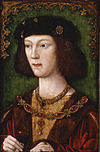 |
28 June 1491 Greenwich Palace son of Henry VII of England and Elizabeth of York |
Catherine of Aragon 11 June 1509 1 child Anne Boleyn Jane Seymour Anne of Cleves Catherine Howard Catherine Parr |
28 January 1547 Whitehall Palace aged 55 |
| Henry's older brother Arthur, Prince of Wales predeceased their father, so Henry was made Prince of Wales and succeeded his father as Henry VIII in 1509, and all of his titles merged with the crown | ||||
Fourth creation, 1605–1625
| Name | Portrait | Birth | Marriage(s) | Death |
|---|---|---|---|---|
| Charles Stuart ("Saint Charles the Martyr") House of Stuart 1605–1625 also: Prince of Wales and Earl of Chester (1616), Duke of Cornwall (1337), Duke of Rothesay (1398), Duke of Albany, Marquess of Ormond (1600), Earl of Carrick (1398), Earl of Ross (1600), Baron Renfrew (1398), Lord Ardmannoch (1600), Lord of the Isles, Prince and Great Steward of Scotland (1398) |
 |
19 November 1600 Dunfermline Palace son of James I of England and Anne of Denmark |
Henrietta Maria of France 13 June 1625 9 children |
30 January 1649 Whitehall Palace aged 48 |
| Charles' older brother Henry Frederick, Prince of Wales predeceased their father, so Charles was made Prince of Wales, and went on to succeed as Charles I in 1625, when his titles all merged with the crowns | ||||
Fifth creation, (1633) 1644–1685
| Name | Portrait | Birth | Marriage(s) | Death |
|---|---|---|---|---|
| James Stuart House of Stuart 1633/1644–1685 also: Duke of Albany (1660), Earl of Ulster (1659) |
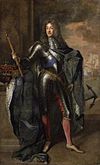 |
14 October 1633 St. James's Palace son of Charles I of England and Henrietta Maria of France |
Anne Hyde 3 September 1660 8 children Mary of Modena 21 November 1673 7 children |
16 September 1701 Château de Saint-Germain-en-Laye aged 67 |
| Prince James was styled Duke of York from birth and officially created as such in 1644. When his brother died without legitimate male issue, James succeeded as James II & VII in 1685, and his titles merged with the crowns | ||||
Dukes of York and Albany
After the Union of Great Britain, the Hanoverian kings liked to grant double titles (one from one constituent country, one from another) to emphasise unity.
First creation, 1716–1728
| Name | Portrait | Birth | Marriage(s) | Death |
|---|---|---|---|---|
| Prince Ernest Augustus House of Hanover 1716–1728 also: Prince-Bishop of Osnabrück (1715–1728), Earl of Ulster (1716) |
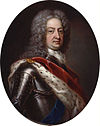 |
7 September 1674 Osnabrück son of Ernest Augustus, Elector of Brunswick-Lüneburg and Sophia of the Palatinate |
never married | 14 August 1728 Osnabrück aged 53 |
| Prince Ernest was the younger brother of George I and died without issue | ||||
Second creation, 1760–1767
| Name | Portrait | Birth | Marriage(s) | Death |
|---|---|---|---|---|
| Prince Edward House of Hanover 1760–1767 also: Earl of Ulster (1760) |
 |
25 March 1739 Norfolk House son of Frederick, Prince of Wales and Augusta of Saxe-Gotha |
never married | 17 September 1767 Prince's Palace of Monaco aged 28 |
| Rather than the second son of the sovereign, Prince Edward was the second son of Frederick, Prince of Wales, and the younger brother of George III. Edward died without issue while still in his 20s after a short illness | ||||
Third creation, 1784–1827
| Name | Portrait | Birth | Marriage(s) | Death |
|---|---|---|---|---|
| The Prince Frederick House of Hanover 1784–1827 also: Earl of Ulster (1784) |
 |
16 August 1763 St. James's Palace son of George III of the United Kingdom and Charlotte of Mecklenburg-Strelitz |
Frederica Charlotte of Prussia 29 September 1791 No children |
5 January 1827 Rutland House aged 63 |
| Prince Frederick separated from his only wife Frederica Charlotte (with whom he had no children) but was rumoured to have fathered several illegitimate children | ||||
Dukes of York
After Queen Victoria decided against awarding the available dukedom to her second son as was traditional (possibly due to its Hanoverian connections), she eventually granted the dukedom of York (alone, rather than "York and Albany") to her eldest son's second (but by then eldest living) son.
Sixth creation, 1892–1910
| Name | Portrait | Birth | Marriage(s) | Death |
|---|---|---|---|---|
| The Prince George House of Windsor 1892–1910 also: Prince of Wales and Earl of Chester (1901), Duke of Rothesay, Earl of Carrick (1398), Earl of Inverness (1600), Baron Renfrew (1398), Baron Killarney (1892), Lord of the Isles, Prince and Great Steward of Scotland (1398) |
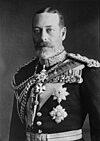 |
3 June 1865 Marlborough House son of Edward VII of the United Kingdom and Alexandra of Denmark |
Mary of Teck 6 July 1893 6 children |
20 January 1936 Sandringham House aged 70 |
| Prince George became George V in 1910, and his titles merged with the crown | ||||
Seventh creation, 1920–1936
| Name | Portrait | Birth | Marriage(s) | Death |
|---|---|---|---|---|
| The Prince Albert House of Windsor 1920–1936 also: Earl of Inverness, Baron Killarney (1920) |
 |
14 December 1895 Sandringham House son of George V of the United Kingdom and Mary of Teck |
Elizabeth Bowes-Lyon 26 April 1923 2 children |
6 February 1952 Sandringham House aged 56 |
| Prince Albert succeeded as George VI upon his brother's abdication in 1936, and his titles merged with the crown | ||||
Eighth creation, 1986–Present
| Name | Portrait | Birth | Marriage(s) | Death |
|---|---|---|---|---|
| The Prince Andrew House of Windsor 1986–present also: Earl of Inverness, Baron Killyleagh (1986) |
 |
19 February 1960 Buckingham Palace son of Elizabeth II of the United Kingdom and Prince Philip, Duke of Edinburgh |
Sarah Ferguson 23 July 1986 – May 30, 1996 (divorce) 2 children |
current holder |
| Prince Andrew has no sons. | ||||
Possible future of the title
Under current law the eighth creation will become extinct on Andrew's death (unless he remarries and has a son), and the then monarch may then recreate the title; if he (or she) follows tradition, he may create his own second son Duke of York. If Charles is king, the title would thus go to his second son Prince Harry. However, if by this time Prince Harry has already received a Dukedom (such as Cambridge or Sussex), the title might be reserved for future use. Additionally, the large age gap between Prince Andrew and Prince Charles decreases the likelihood that the title would even be available for Charles to grant if he were to be king.
The dukedoms of York, Cornwall, Lancaster, Clarence and Gloucester compose the original group created between 1337 and 1385. Prince Charles is the Duke of Cornwall; The Queen is the Duke of Lancaster; and her cousin Prince Richard is the Duke of Gloucester. The only one of these titles not currently extant is Clarence, last held by Queen Victoria's grandson who died in 1892.
External links
See also
- Duke of Albany
- Earl of Inverness, a subsidiary title of the current creation
- Henry Benedict Stuart, created Duke of York by the titular King James III in 1725. Recognised as Duke of York by the Papacy, Modena, France, and Spain. Died without issue in 1807.
Places named after Dukes of York:
- Duke of York Archipelago, Canada
- Duke of York Bay, Canada
- Duke of York Island, Antarctica
- Duke of York Island, Papua New Guinea
- Duke of York Islands
- Duke of York's Royal Military School
- New York (both the US state and city)
Other uses of as a name:
- Duke of York was one of the GWR 3031 Class locomotives that were built for and run on the Great Western Railway between 1891 and 1915.
| Dukes of York | |
|---|---|
| |
| italics denote Dukes of York and Albany |
| Extant dukedoms in the peerages of Britain and Ireland | ||
|---|---|---|
| Royal dukedoms |  | |
| England | ||
| Scotland | ||
| Great Britain | ||
| Ireland | ||
| United Kingdom | ||
| Italics: This title is held by a peer who holds another of higher precedence. | ||